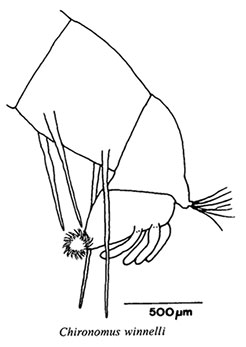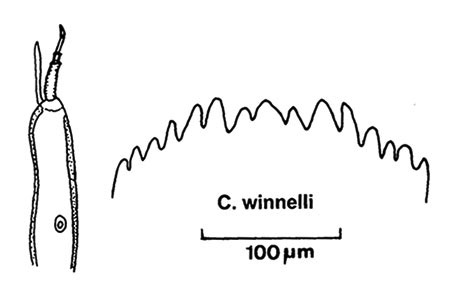Species 3v. C. winnelli Wülker, 2007. Originally C. species Michigan B - Wülker, Devai and Devai (1989) Adult:
The adults of this species are not known for sure, but adults reared from fluviatilis-larvae in the area are similar to those of C. decorus-group species. Pupa: - not known. Fourth instar larva of fluviatilis-type i.e. ventral tubules scimitar shaped with relatively pointed ends, with no lateral tubules. 
Posterior end of holotype larva of C. winnelli, from Wülker (2007) Length about 5.2-12.5 mm (presumably small larvae are third or early fourth instar). Ventral tubules longer than width of abdomen, posterior pair shown as longer. Anal tubules (above) well developed, figured as at least 4 times longer than wide, sometimes constricted at midpoint, ventral pair longer. Head capsule narrower than normal (width 0.39-0.49 mm), with gula sometimes slightly darkened distally or may be pale, frontoclypeus pale.
From published figure (below), fourth laterals of Mentum appear to be only slightly reduced (type I-ii); and central trifid tooth with the c2 teeth fairly well separated (type IIA); it appears the 6th laterals arise at the same level as other laterals.
About 24 (23-25) striae on each ventromental plate.
Antenna (below) with basal antennal segment 101 (94-121) µm) about 2.7-3.5 times longer than wide (30-39 µm), Ring organ just over a quarter way up from base of the segment; AR 2.1-2.3; A2 length 21-30 µm., about 0.31 of A1
Mandible with all inner teeth darkened (type IIIB).
Antenna and mentum of C. winnelli, from Wülker (2007)Cytology: 4 polytene chromosomes with the thummi arm combination: AB, CD, EF, G.
Centromeres not heterochromatic. Arm G with subterminal nucleolus and BR near middle of the arm. No nucleoli in the other chromosomes Sometimes a puff developed in arm B and C. No polymorphism found in specimens examined.
win A1: 1a-e, 9a-e, 2d-3e, 17-16, 1f-2c, 13-14, 15e-a, 3f-i, 12-10, 4-7, 8g-a, 17e-19
win B1: Puff with dark bands (groups 7-8) near middle of the arm, with typical groups 24-28 just proximal to them.
win C1: typical group 2d-5b near middle of the arm, a puff developed near the contromere
win D1: approx. 1-3, 11-12, 15-13d, 4(?)-8,13c-a(?), 16(?), 9-10, 17-24 i.e. as mozleyi D1
win E1: 1-2b, 11b-10c, 3f-4, 10b-5, 3e-2c, 11c-13
win F1: 1a-1, 9-5d, 14-17, 10a-d, 13b-11, 13cd, 18-19b, 2-5c, 19c-23 Found: Michigan - Lake Michigan (Type locality). From depths of 6-12 m in fine sand sediments. Larva is most easily distinguished from the co-habiting C. mozleyi by the narrower head capsule, the mentum type, and the lower number of striae on the ventromentum.This species is a member of the C. decorus-group. Sequences for arms A, E and F given in Wülker, Devai and Devai (1989) as C. sp. Michigan B. Description of the species by Wülker (2007). Holotype in Zoologische Staats Sammlung, Munich. See also C. mozleyi. C. bifurcatus, C.sp. b, C. sp. c, C. sp. j, C. sp. 2a, C. sp. 2b, C. 'butleri', C. sp. 3h, C. sp. 3i, C. sp. 3j, C. harpi, C. blaylocki, C. decorus Johannsen,[ Return to Index| Go to References ] |

